Audio amplifier classes
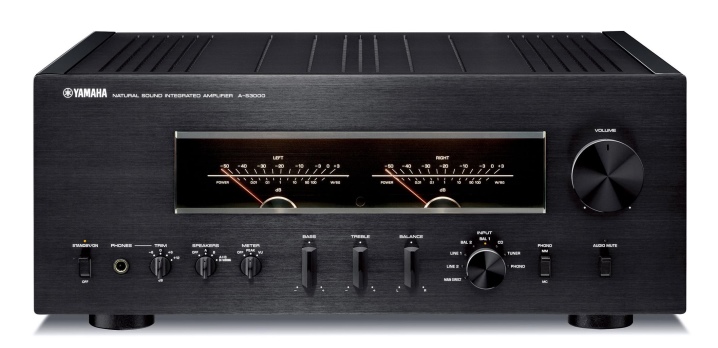
Surely many have heard that modern amplifiers can belong to different classes. However, people who are far from acoustic systems and technical features of sound equipment can hardly imagine what is hidden behind the letter designations.
In our review, we will talk in more detail about what the classes of amplifiers are, what they are, and how to choose the optimal model.
Classification
The class of the amplifier is the value of the output signal at which it is driven by the sinusoidal input signal in the functional circuit during one operating cycle and changes as a result of this influence. The classification of amplifiers into classes depends on the linearity parameters of the mode used to amplify the incoming signals from categories with increased accuracy with rather reduced efficiency to completely non-linear. In this case, the accuracy of sound reproduction of the signal is not so great, but the efficiency is quite high. All other classes of amplifiers are some kind of intermediate models between these two groups.

First group
All classes of amplifiers can be conditionally divided into two subgroups. The first includes the classical controlled models of classes A, B, as well as AB and C. Their category is determined by the parameter of their conductivity in a certain section of the output signal. Thus, the operation of the built-in transistor at the output is located in the middle between "off" and "on".

Second group
The second category of devices includes more modern models, which are considered the so-called switching classes - these are models D, E, F, as well as G, S, H and T.
These amplifiers use pulse width modulation as well as digital circuitry to continuously convert the signal between fully off and fully on. As a consequence, there is a powerful exit in the saturation region.
Description of popular classes
We will talk about different classes of amplifiers in more detail.
A
Class A models are most widely used due to their simplicity of design. This is due to several parameters of the distortion of the input signal and, accordingly, the high sound quality in comparison with all other categories of amplifiers. Models in this category are characterized by high linearity compared to others.

Typically, class A amplifiers use a single version of transistors in their work. It is connected to the basic emitter configuration for the two halves of the signal so that the germanium transistor will invariably pass through it even if there is no phase signal. This means that at the output, the stage will not fully pass into the signal cutoff and saturation region. It has its own offset point approximately at the center of the load line. This structure leads to the fact that the transistor simply does not activate - this is considered one of its basic disadvantages.
In order for a device to be classified as belonging to this class, the zero no-load current in the output stage must equal or even exceed the load current limit to ensure the maximum output signal.
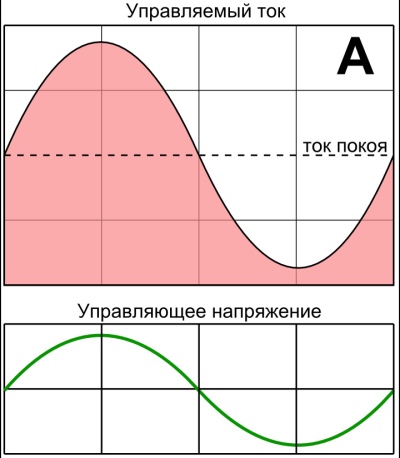
Since class A devices are single-ended and operate in the linear zone of all specified curves, one output device passes through a full 360 degrees, in which case the category A device fully corresponds to the current source.
Since amplifiers in this category operate, as we have already said, in the ultra-linear region, the DC bias must be set correctly. - this will ensure proper operation and give a sound stream with a power of 24 watts. However, due to the fact that the output device is always in the off state, it continuously conducts current, and this creates conditions for a constant loss of power in the entire structure. This feature leads to the release of a large amount of heat, while their efficiency is rather low - less than 40%, which makes them impractical when it comes to some kind of powerful acoustic systems. Besides, due to the increased no-load current of the installation, the power supply must have the appropriate dimensions and be filtered as much as possible, otherwise the sound of the amplifier and third-party hum cannot be avoided. It was these shortcomings that led manufacturers to continue working on amplifiers in a more efficient category.
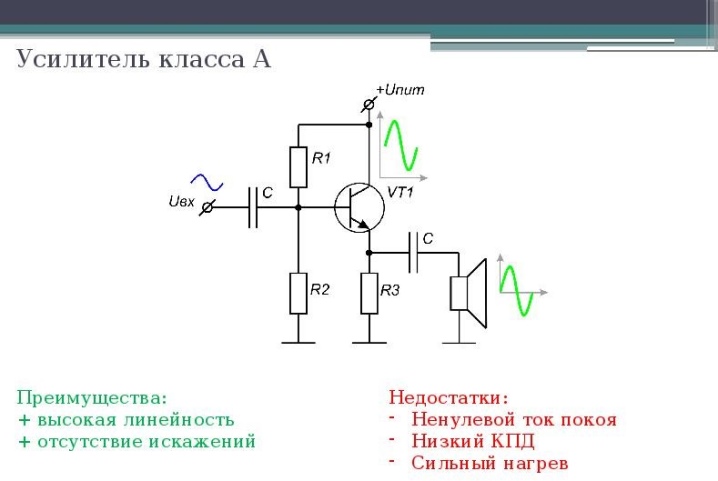
V
Class B amplifiers have been designed by manufacturers to address the low efficiency and overheating problems associated with the previous category. In their work, category B models use a pair of additional transistors, usually bipolar. Their difference is that for both halves of the signal, the output front is built according to a push-pull circuitry, so each transistor device provides amplification of only half of the output signal.

There is no basic DC level bias current in amplifiers of this class, since its quiescent current is zero, therefore DC power parameters are usually small. Accordingly, its efficiency is much higher than that of devices A. At the same time when the signal is positive, the positive-biased transistor drives it, while the negative remains off. Similarly, at the moment when the input signal becomes negative, the positive is turned off, and the negatively biased transistor, on the contrary, is activated and provides the negative half of the signal. As a result, the transistor, during its operation, spends 1/2 cycle only in the positive or negative half-cycle of the incoming signal.
Accordingly, any transistor device in this category can only pass through a part of the output signal, while in a clear alternation.
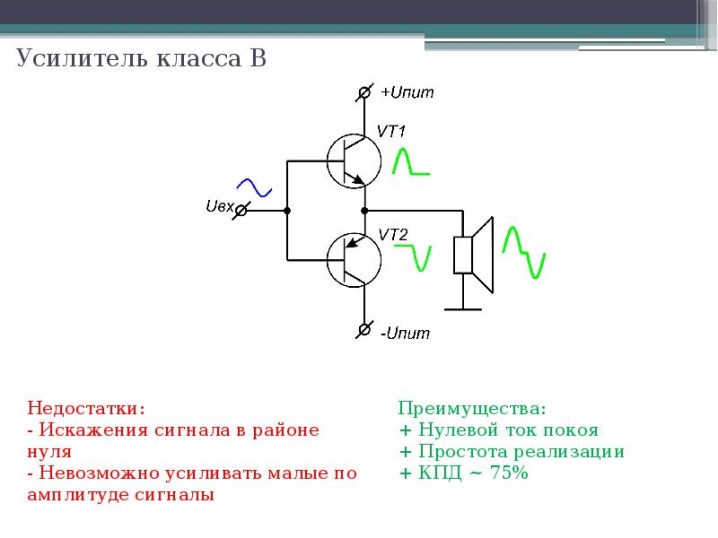
This push-pull design is about 45-60% more efficient than Class A amplifiers. The problems with models of this type are that they give significant distortion at the time of the passage of the audio signal due to the "dead zone" of transistors in the corridor of input voltages with values from -0.7 V to +0.7 V.
As everyone knows from the physics course, the base emitter must provide a voltage of about 0.7 V in order for the bipolar transistor to start full wiring. As long as this voltage does not exceed this mark, the output transistor will not move to the on position. This means that half of the signal that goes into the 0.7 V corridor will start to be reproduced inaccurately. Consequently, this makes Category B devices practically unsuitable for use in precision acoustic installations.
For to overcome these distortions, so-called class AB compromise devices were created.
AB
This model is a kind of tandem design of category A and category B. Today, type AB amplifiers are considered one of the most common design options. By the principle of their operation, they are a bit like products of category B, with the only exception that both transistor devices can conduct a signal at the same time near the intersection point of the oscillograms. This completely eliminates all the signal distortion problems of the previous Group B amplifier.The difference is that a pair of transistors has a fairly low bias voltage, typically 5 to 10% of the quiescent current. In this case, the conducting device remains on longer than the time of one half-cycle, but at the same time it is much less than the full cycle of the input signal.

It is safe to say that the type AB device is considered an excellent compromise between Class A and Class B models in terms of efficiency and linearity.and, while the conversion efficiency of the audio signal is approximately 50%.
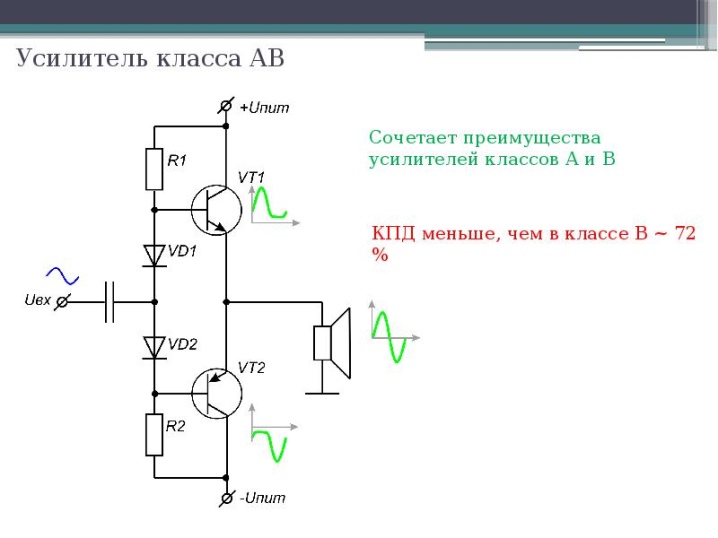
WITH
The design of the C-class units has maximum efficiency, but at the same time rather poor linearity compared to all other categories. The C-class amplifier is quite noticeably biased, so the input current goes to zero and remains at this level for more than 1/2 cycle of the incoming signal. At this time, the transistor is in standby mode to turn it off.
This form of bias of the transistor provides the greatest efficiency of the device, its efficiency is about 80%, but at the same time it introduces rather significant sound distortions in the output signal.
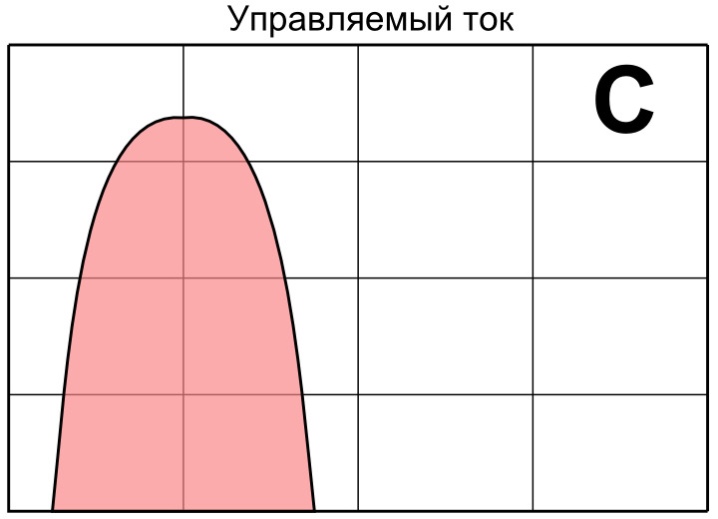
These design features make it impossible to use amplifiers in loudspeaker systems. As a rule, these models have found their area of use in high-frequency generators, as well as in certain versions of radio-frequency amplifiers, where current pulses emitted at the output are converted into sinusoidal waves of a given frequency.
D
The amplifier of category D refers to two-channel non-linear pulse models, they are also called PWM amplifiers.
In the vast majority of audio systems, the output stages operate in either class A or AB. In integrated amplifiers of group D, the power dissipation of the line inputs is significant even in the case of their maximum complete, almost ideal implementation. This gives D-class models a significant advantage in most areas of application due to minimal heat generation, reduced weight and dimensions of the device and, accordingly, reduced cost of products, while the battery life in such models is increased in comparison with models of other designs.
As a rule, these are high-voltage models, they are designed for a board of 10,000 watts.

Other
Class F amplifier. These models provide increased efficiency, their efficiency is about 90%.
Class G amplifier. This amplifier is, in fact, an advanced high-linearity design of the AB class TDA base unit. Models in this category can automatically switch between different power lines if the parameters of the incoming signal change. Such switching greatly reduces power consumption and, accordingly, reduces power consumption caused by heat loss.
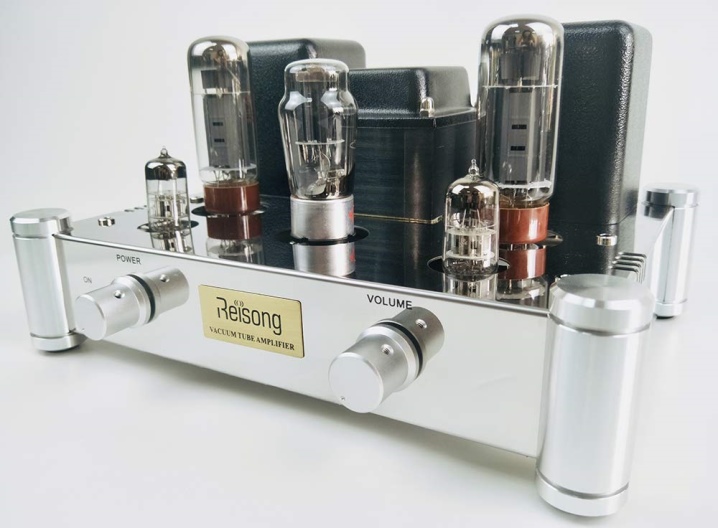
Class I amplifier. Such models have a couple of sets of additional output devices. Before switching on, they are located in a push-pull configuration. The first device switches the positive part of the signal, and the second one is responsible for switching the negative part, similar to Category B amplifiers. If there is no audio signal at the input, or if the signal reaches the zero crossing point, the switching mechanism turns on and off at the same time as the main cycle.

Class S amplifier. This class of amplifiers is classified as a non-linear switching mechanism. By the mechanism of their work, they are somewhat similar to amplifiers of category D. Such an amplifier converts analog input signals into digital ones, amplifying them many times over. Thus, in order to increase the output power, usually the digital signal of the switching device is either fully on or completely off, so the efficiency of such devices can be 100%.
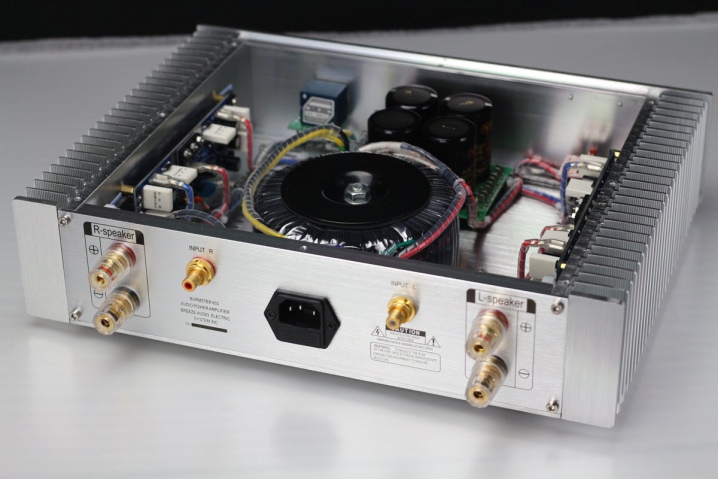
Class T amplifier. Another option for a digital amplifier. Today, such models are gaining more and more popularity due to the presence of microcircuits that allow digital processing of the incoming signal, as well as built-in multi-channel 3D sound amplifiers. This effect is provided by a design that allows analog signals to be converted into higher digital-type PWM sounds. The design of the Class C devices combines the characteristics of a low distortion signal similar to the AV category, while maintaining efficiency at the level of the Class D models.
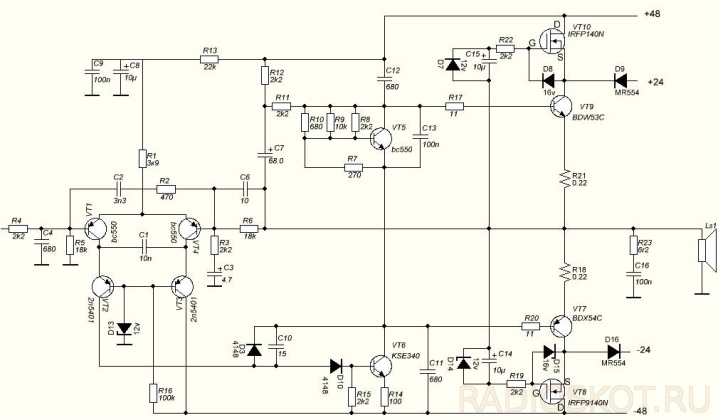
How to determine?
To begin with, let's dwell on how the amplifier works in principle. Surely you will be surprised, but in fact the factory amplifier does not amplify anything. In fact, the mechanism of its operation resembles the operation of the simplest crane: you twist the handle and the water from the water supply begins to pour, stronger or weaker, and if you twist it, the flow will be blocked. In amplifiers, all processes occur in the same way. From the powerful power supply module, current flows through the speaker connected to the device. In this case, the function of the tap is taken over by transistors - at the output, the degree of their closing and opening is controlled by the signal that passes to the amplifier. From how exactly this crane functions, that is, how the output transistors operate, and the class of amplifiers is determined.
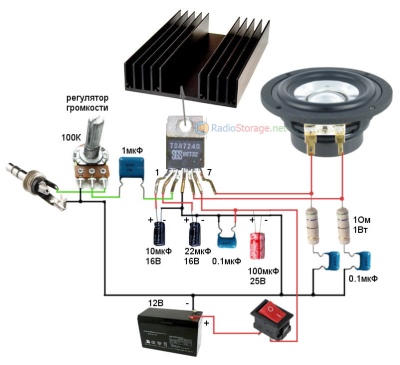
If we are talking about AB devices, then transistors in them can have the unpleasant property of opening and closing disproportionately to the signals arriving at them. Thus, their work becomes unchanged. Returning to the analogy with the faucet - you can turn the handle of the faucet, but the water will flow weakly at first, and then suddenly the flow will suddenly increase.
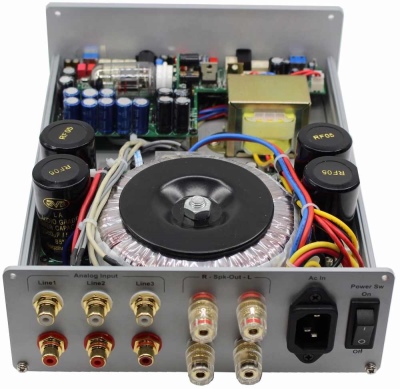
For this reason transistors of category AB have to be kept in a slightly open state even if there is no signal. This is necessary so that they start working immediately, and not wait until the signal reaches a certain level - only in this case the amplifier will be able to reproduce sound with minimal distortion. In practice, this means that some of the useful energy is wasted. Just imagine that you turn on all the water taps in the apartment, and a small trickle of water will continuously flow out of them. As a result, the efficiency of such models does not exceed 50-70%, it is the low efficiency that is the main disadvantage of the AV class amplifiers.
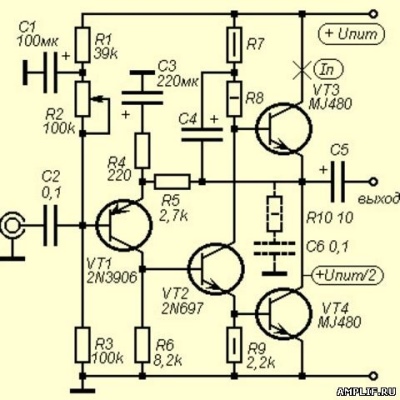
If we talk about D-class devices, then the principle of their operation is absolutely the same: they have their own output transistors that can turn on and off. Thus, the passage of current through the speakers connected to them is regulated, but the signal already controls their opening, which by its configuration is very far from the incoming one.
This is how the signal is fed to the output transistors of Class D devices. In this case, they will function completely differently: either close in full, or open without any intermediate values. This means that the efficiency of such models can be close to 100%.
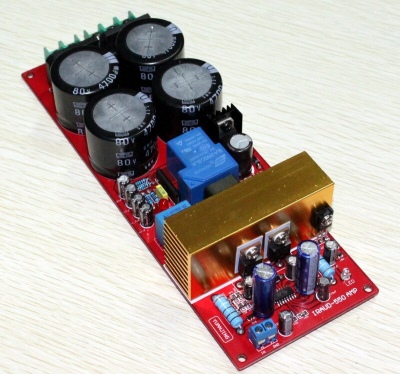
Of course, it is too early to send such signals to audio systems, first it should return to the standard configuration. This can be done by means of an output choke, as well as a capacitor - after processing them, an amplified signal is formed at the output, which in its shape completely repeats the input one. It is he who is transmitted to the speakers.
The main advantage of D-class devices is the increased efficiency. and, accordingly, more gentle energy consumption
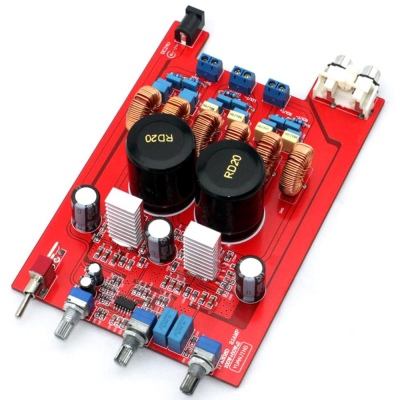
For a long time it was believed that for connecting high-quality speaker systems, the AB amplifiers will be the optimal solution... Models of category D gave the conversion of the incoming signal to a pulsed signal with a reduced frequency, as a result, it gave good sound only in subwoofer mode.Nowadays, technology has taken a big step forward, and today there are already high-speed transistors that can open and also close almost instantly, there are quite a lot of D-class broadband devices in stores.
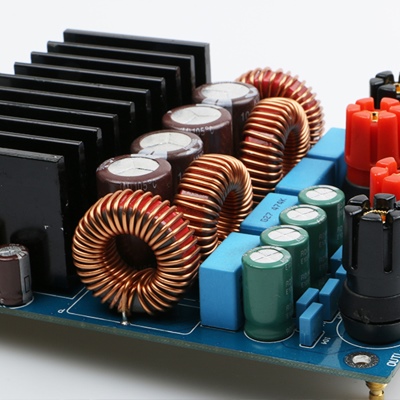
These models are intended for use not only with subwoofers, but also with modern speaker systems of all types. For those options where high power is not required, it makes sense to purchase a fairly compact amplifier.
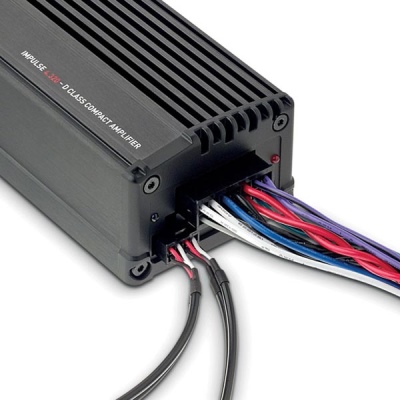
Thus, if you have enough space to connect the speaker, then you may well choose an AV-class model. For several decades of existence, the circuitry of these models has been well developed, they give a fairly good sound quality, and in the event of a breakdown, you can easily repair them at the nearest service center.
If the area for sound installation is limited, then you should take a closer look at the wideband models of group D. With the same power parameters as the AV-class products, they are much smaller and lighter, moreover, they heat up less, and some models even allow them to be installed secretly with the least interference.

For connecting subwoofers, the D-class sets the maximum advantage, since the bass tone block is the most energy-consuming frequency range - in this case, the efficiency of the product is of fundamental importance, and in this there are simply no competitors to the D-class products.
In this video, you can more clearly familiarize yourself with the classes of sound amplifiers.













The comment was sent successfully.